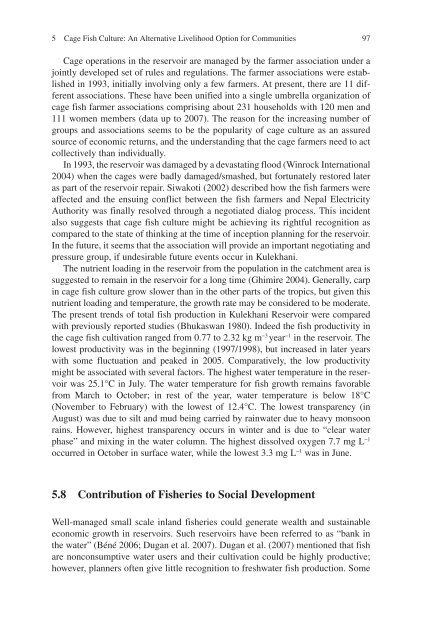Success Stories In Asian Aquaculture - Library - Network of ...
Success Stories In Asian Aquaculture - Library - Network of ...
Success Stories In Asian Aquaculture - Library - Network of ...
- No tags were found...
Create successful ePaper yourself
Turn your PDF publications into a flip-book with our unique Google optimized e-Paper software.
5 Cage Fish Culture: An Alternative Livelihood Option for Communities97Cage operations in the reservoir are managed by the farmer association under ajointly developed set <strong>of</strong> rules and regulations. The farmer associations were establishedin 1993, initially involving only a few farmers. At present, there are 11 differentassociations. These have been unified into a single umbrella organization <strong>of</strong>cage fish farmer associations comprising about 231 households with 120 men and111 women members (data up to 2007). The reason for the increasing number <strong>of</strong>groups and associations seems to be the popularity <strong>of</strong> cage culture as an assuredsource <strong>of</strong> economic returns, and the understanding that the cage farmers need to actcollectively than individually.<strong>In</strong> 1993, the reservoir was damaged by a devastating flood (Winrock <strong>In</strong>ternational2004) when the cages were badly damaged/smashed, but fortunately restored lateras part <strong>of</strong> the reservoir repair. Siwakoti (2002) described how the fish farmers wereaffected and the ensuing conflict between the fish farmers and Nepal ElectricityAuthority was finally resolved through a negotiated dialog process. This incidentalso suggests that cage fish culture might be achieving its rightful recognition ascompared to the state <strong>of</strong> thinking at the time <strong>of</strong> inception planning for the reservoir.<strong>In</strong> the future, it seems that the association will provide an important negotiating andpressure group, if undesirable future events occur in Kulekhani.The nutrient loading in the reservoir from the population in the catchment area issuggested to remain in the reservoir for a long time (Ghimire 2004) . Generally, carpin cage fish culture grow slower than in the other parts <strong>of</strong> the tropics, but given thisnutrient loading and temperature, the growth rate may be considered to be moderate.The present trends <strong>of</strong> total fish production in Kulekhani Reservoir were comparedwith previously reported studies (Bhukaswan 1980) . <strong>In</strong>deed the fish productivity inthe cage fish cultivation ranged from 0.77 to 2.32 kg m −3 year −1 in the reservoir. Thelowest productivity was in the beginning (1997/1998), but increased in later yearswith some fluctuation and peaked in 2005. Comparatively, the low productivitymight be associated with several factors. The highest water temperature in the reservoirwas 25.1°C in July. The water temperature for fish growth remains favorablefrom March to October; in rest <strong>of</strong> the year, water temperature is below 18°C(November to February) with the lowest <strong>of</strong> 12.4°C. The lowest transparency (inAugust) was due to silt and mud being carried by rainwater due to heavy monsoonrains. However, highest transparency occurs in winter and is due to “clear waterphase” and mixing in the water column. The highest dissolved oxygen 7.7 mg L −1occurred in October in surface water, while the lowest 3.3 mg L −1 was in June.5.8 Contribution <strong>of</strong> Fisheries to Social DevelopmentWell-managed small scale inland fisheries could generate wealth and sustainableeconomic growth in reservoirs. Such reservoirs have been referred to as “bank inthe water” (Béné 2006 ; Dugan et al. 2007) . Dugan et al. (2007) mentioned that fishare nonconsumptive water users and their cultivation could be highly productive;however, planners <strong>of</strong>ten give little recognition to freshwater fish production. Some
















